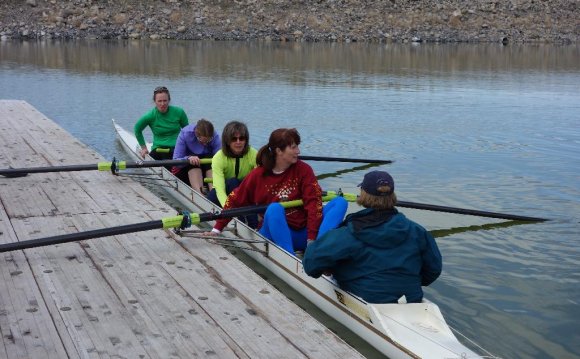
WINTER / COLD WEATHER ROWING
Rowing when the water temperature falls below 50º should be done with great consideration and caution. Hypothermia is a swift and incapacitating killer that strikes when the combination of cold weather and moisture work to decrease body temperature. It can take mere minutes before a full-size adult is incapable of helping herself/himself once hypothermia has set in. Keep in mind that you don't have to fall in the water to get hypothermia. Cold air temperatures and any moisture on the body (from being splashed, rain, sleet, snow) can lead to hypothermia.
The following measures are suggested when working out on the water in cold weather:
1. Sign out in the logbook AND let others know when you will be on the lake
2. Four Oar Rule is recommended : The boat must have a minimum of four oars on the water, or
3. Buddy System: is recommended If individuals go out they should do so in 2 boats (or preferably 3 boats- 1 to go for help / 1 to stay with the rower)
4. Wear inflatable mandatory, compact life vest or wet suit
5. Stay close to shore which means row toward Black Rock or Salt Air and NOT out toward the middle of the lake as you must be able to get out of the water in 5 minutes you can see the bottom and row in 16” to 3’ of water.
6. Carry a noisemaker of some kind should in each shell and be attached in some manner so as not to be lost if the shell capsizes. A cell phone is a requirement in winter rowing conditions
The only true safety device or practice other than common sense is a support/coaching launch. In the event of an emergency, a well-prepared safety launch can assist the individuals in question and transport them to safety. Even then, hypothermia is an issue. All individuals should ask themselves before launching if being on the water is the best and only way to train.
HYPOTHERMIA
Hypothermia is a condition that occurs when the temperature of the human body is lowered to a dangerous point due to exposure to cold and/or wet conditions. Cold temperatures and wet conditions work together to pull heat away from the body, lowering the body's core temperature. Even in mild conditions, the addition of rain or submersion in cold water and can sufficiently reduce body warmth to trigger hypothermic conditions in the body. A person's condition can degrade rapidly, impairing breathing and coordination, making it impossible to swim or keep one's head above water. Emergency action needs to be taken no matter what the level of hypothermia.
EARLY HYPOTHERMIA
Symptoms: Rapid shivering, numbness, loss of strength and coordination, semi- consciousness.
Action: Maintain open airway. Transfer to a warm environment as soon as possible. Remove wet clothing. Use blankets to help warm individual or, if available, a warm shower. Warm torso area first. Seek medical attention.
PROFOUND HYPOTHERMIA
: Person will be pale, stiff, and cold, unresponsive to stimuli, and possibly unconscious. Little or no cardiac or repository activity will be present.
YOU MIGHT ALSO LIKE












